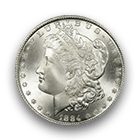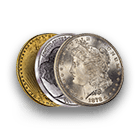Some designers are not artists. Some artists are not designers. But Mr. Chen Jian was both, and then some. When he passed away on February 24, 2025, at the age of 84, the numismatic world lost one of its most iconic figures.
The acclaimed Shanghai artist was the creative force behind China’s most recognizable modern coin: the 1982 gold Panda...
Peter Anthony (P.A.): Tell us a little bit about how you decided to become a designer.
Mr. Chen Jian (C.J.): In 1941, I was born in Shaoxing, Zhejiang Province.
P.A.: So, not so far from Shanghai.
C.J.: I liked art. I liked painting when I was in elementary school, but at this time, I didn’t draw well. One day, my teacher gave our class an assignment to draw something from a photo. My photo was of the Statue of Liberty. I used an enlarging grid to magnify this photo. In this method, the image is divided into small sections. It allows you to put that there and move this place over there to enlarge it. It is a kind of basic enlargement tool. Also, in those days, I liked to drink a chilled hot pot brew that my mom made every day and served in a cup. The torch on the statue reminded me of this and made me enthusiastic about the project. The teacher thought my drawing looked so much like the statue that he gave me a 98 red envelope. In fact, I kept and still have this drawing, together with my memories.
After graduating from high school, I moved to the Shanghai Fine Arts Academy, which is a specialized college. There they teach some essential skills such as sketching, watercolor painting, Chinese painting, calligraphy, and other art methods. Many famous artists and designers studied at this college, and I attended it for two years. I had some outstanding teachers there, including Mr. Wang. Sketching is the most fundamental of art skills. To be good, it must be done quickly. This is among the skills I learned. I graduated in 1962 and was immediately assigned to the Shanghai Mint. One thing I needed to learn was the engraving and sculpting skills necessary for coin design. Mostly, I taught this to myself when I came to the factory. There was also a technician from Italy who lived in China and taught engraving. A colleague mentioned him to me and so I enrolled in his carving class. It was interesting to learn from this Italian man as his techniques were new to China. During the construction and carving process, he used a knife to carve directly.
Well, one thing on my mind these days is that technology is so advanced now that there are many things that rely totally on computers. I hope that younger coin designers will still be able to draw pictures and do handicrafts, and that they will still be able to use them in their daily lives. Now, there are so many things that computers do that traditional methods don’t need to be used, and that’s not good. We still need to experience life. There is an increase in the body experience from working with tangible materials, right? It elicits emotions, as well.
P.A.: Recently, I met a young designer for film. I showed him a watercolor and told him that the black lines were painted with ink so they would be waterproof. “Ink?” he exclaimed. “I have an ink tool in my drawing program. I have never met anyone who uses real ink!”
C.J.: Well, some techniques have already been lost. In coins, the pattern on the coin dies is mainly intaglio, or engraved. While I worked at the Mint, I also participated in two short-term professional study courses. One for drawing and the other a sculpture class, a refresher course. These lasted half a year. Every week, I went there for one day. My opinion afterward was that Buddhism would be a better source of inspiration. There were also study groups organized at the Shanghai Mint, and in later years, there were many trips to study abroad. These were organized so that we should go out and see more things.
P.A.: What was your work like at the Shanghai Mint?
C.J.: During the Cultural Revolution, many Chinese people wanted to wear badges with the image of Chairman Mao Zedong. I not only designed the badges, but I also carved the reliefs, or plasters, for the badges’ production. We also made badges and medals for the army. The Mint supplied these. The design and engraving process for a badge is very similar to a coin’s. As long as you say you want to make a badge, you will also exercise your basic skills. Yes, yes, yes, this is definitely true. It was a special time period.
P.A.: When did you begin to design coins?
C.J.: The first is the golden medal, yes, it is the scene in Beijing Scenery medals in 1979. Oh, the scenery in Beijing, there is no substitute for the scenery in the north! I often went to Hong Kong to promote it. The mintage was a total of 2,000 sets, and it sold out, so I think that the Chinese leadership thinks, “Hey, this is great, you can repeat this success.” For the 30th Anniversary of the Founding of the People’s Republic of China, there was an open competition for the designs. Members of the Shanghai Fine Arts college professors and students submitted designs to the Mint. Everyone drew good pictures. In total, there were about 30 or 40 entries. But in the end, it was decided to use the drawings from the designers of the factory, including myself, so I was chosen to work on the 30th Anniversary of the Founding of the People’s Republic of China coins.
P.A.: How about the 1982 Panda coins?
C.J.: The 1982 Panda is my favorite coin that I designed. It is the one! The panda is not only a rare animal, it is a national treasure of China. It is popular around the world and is the nation’s friendship ambassador. There he is, sitting there like he is playing a game at a table. I wanted this panda to express China’s desire for peace and friendship to the rest of the world. The panda on the 1982 coin looks like it’s saying “Hello” as a greeting. It is an emblem of friendship.
P.A.: You used bamboo as a prop.
C.J.: Well, bamboo is the panda’s favorite food, and pandas live in a bamboo forest. When you see a panda, you immediately think of bamboo. The biggest challenge was how to show the contrast between white and black on a coin that was all one color. The Shanghai Mint did a lot of trial-and-error work. Inspired by wood engraving and new coin design techniques in the West, we developed a special method: first polish the background to make a mirror, and then make the relief frosted. The eyes, ears, and legs were made to be concave/engraved, and other parts were raised from the surface in relief. This gives the design a realistic, three-dimensional quality.
The work began in early 1982 when the Shanghai Mint was given an assignment by the People’s Bank of China to design a coin that features a panda. In the first round of the competition, all the designers submitted sketches. The finalists were sent to the head office in Beijing, and the company decided which one to use. There were around 10 drawings in the final competition to be considered, five designs from Shenyang and five from Shanghai, but only one could be chosen. Each designer has only one. What can I say? This is my job, my actual task is to do the best I can, for better or worse. My design was based on a real panda image. Later, I was still nervous about the internal judging. Ultimately, I was very lucky. I wasn’t surprised, but I was very happy when my design was chosen for the 1982 Panda coin.
P.A.: Did you ever expect the 1982 Panda to become so well-known?
C.J.: I never thought it would be so successful. When I designed the Panda coin, the only thing on my mind was to do my best. Of course, I am happy for its success. And it led to assignments in later years, too.
P.A.: Tell us about the 1983 Panda design that won the Best Gold Coin of the Year Award.
C.J.: The competition process was similar to 1982. For the design, in 1982 the field is mirrored. For 1983, the plan was to make a frosted field behind the panda. There are more shades, or levels, of brightness than the previous year. Also, the pose is different: one walks while the other sits. The engraving technique is different to give the coin texture, and then there is a mirrored ring around the central circle to add contrast. It always feels better to have something darker on top. Then in 1984, oh, I actually quite like this, the panda is very friendly and having fun.
P.A.: What about the 1984 1,000 Yuan, 12-ounce gold Panda coin?
C.J.: This design is basically the same as the 1982 coin but flipped horizontally. I knew that these were being made for Mr. Weiss of Panda America.
P.A.: You also designed some of the Yellow River Culture coins. Did you draw these entirely from your imagination, or were there models?
C.J.: These are based on real people. When I presented this coin design, because we need to consider the composition on our commemorative coin, we needed to recompose it and make many rounds of changes. It’s not this, this, this, this, this. When you work at your factory, you can’t send private messages. The message is entirely what is needed by the company.
P.A.: Do you have any overall thoughts about your career?
C.J.: Chinese coins have a long history of more than 3,000 years, and they are shining today. Since 1979, China’s modern commemorative coins have added more flowers, and hundreds of flowers have blossomed. I’ve had the privilege of growing up in this era and working in this circle. I am grateful to all who taught me, my classmates, and colleagues, and for everyone’s training and help. Well, it’s what I should do. It’s my job to do a little thing and make a contribution to society. I just hope that the younger designers who follow us can do better than us to contribute to this country. Now the conditions are better in all aspects, and the designers will make greater contributions to move ahead. I will add that you can’t rely entirely on machines, you have to rely on your own hands and knowledge to do it well.














 Copper & Nickel
Copper & Nickel
 Silver Coins
Silver Coins
 Gold Coins
Gold Coins
 Commemoratives
Commemoratives
 Others
Others
 Bullion
Bullion
 World
World
 Coin Market
Coin Market
 Auctions
Auctions
 Coin Collecting
Coin Collecting
 PCGS News
PCGS News